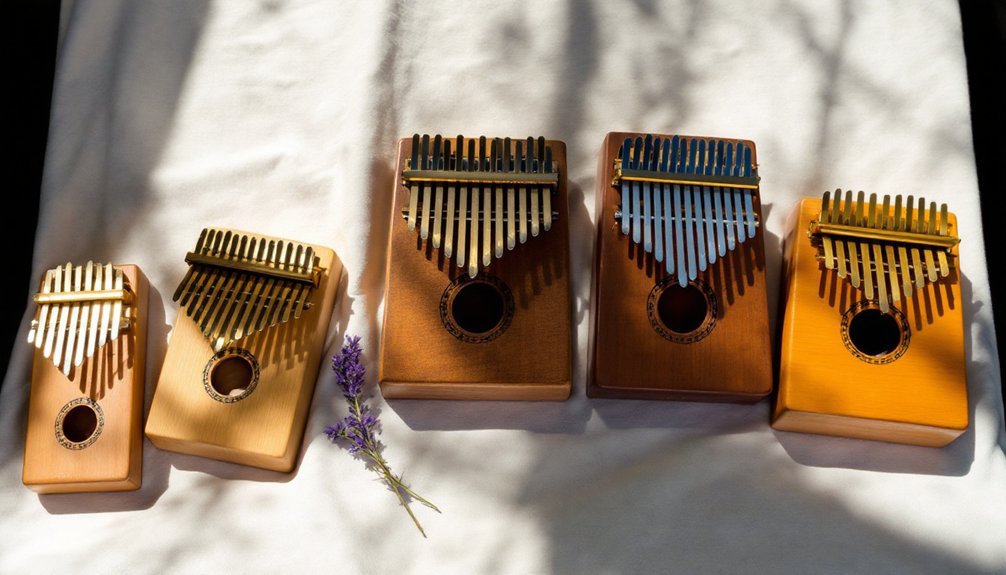If you're drawn to the enchanting sounds of the kalimba, you'll want to start your musical journey with the right instrument. Choosing from countless options can feel overwhelming, especially when you're new to this African-derived thumb piano. You don't need to spend hours comparing features and prices – we've identified seven beginner-friendly kalimbas that'll help you create those mesmerizing melodies you've been dreaming about.
Kalimba 17 Keys Thumb Piano (Portable Mbira)
The Kalimba 17 Keys Thumb Piano stands out as an ideal starter instrument for beginners of all ages, thanks to its thoughtfully designed features. You'll find embossed keys with clear letter markings and an ergonomic hand-rest curve that makes playing comfortable.
The instrument produces soothing, harp-like sounds even with random strumming, and you'll receive everything needed to start playing: a tuning hammer, instruction book, thumb guards, and a protective bag. Whether you're looking to learn quickly or just relax with melodic tones, this portable instrument delivers. You can learn your first song in about five minutes using the included guidance materials.
Best For: Musical beginners, children, and anyone seeking a portable, easy-to-learn instrument that produces calming, melodic sounds.
Pros:
- Easy to learn with embossed keys and included instruction materials
- Produces soothing, harp-like sounds even for beginners
- Complete kit includes all necessary accessories and protective carrying bag
Cons:
- Tightly packed keys may require practice to avoid accidental bumps
- Song book could use more clarity regarding specific keys
- May need regular tuning adjustments for optimal sound quality
Fixm Mini Kalimba Thumb Piano 8 Keys (2 Pack)
Aspiring musicians seeking a gentle introduction to kalimbas will find the Fixm Mini Kalimba 8 Keys set invigoratingly approachable. With just 8 keys instead of the traditional 17, you'll have an easier time learning basic melodies. The set includes two mini kalimbas, making it perfect for sharing or practicing with a friend.
Made from acrylic and mahogany with mineral keys, these instruments have undergone strict quality testing. While they're not professional-grade instruments, and you might find some tuning inconsistencies, they're ideal for beginners exploring their musical interests. You'll need fingernails to play effectively, but the compact size lets you practice anywhere.
Best For: Beginners, children, and casual music enthusiasts looking for an affordable and simple introduction to playing the kalimba thumb piano.
Pros:
- Comes as a 2-pack, making it perfect for sharing or practicing with others
- Simplified 8-key design makes it less overwhelming for beginners compared to 17-key models
- Compact and portable size with attractive gift packaging
Cons:
- Some units may have tuning inconsistencies or sound quality issues
- Requires fingernails to play effectively, which might be challenging for some users
- Not suitable for serious musicians or advanced players seeking professional sound quality
CAHAYA 17-Key Kalimba Thumb Piano (CY0338)
Music novices seeking an accessible entry point into playing instruments will find their perfect match in the CAHAYA 17-Key Kalimba Thumb Piano. Crafted from naturally air-dried mahogany with mineral metal keys, this portable instrument delivers rich, resonating tones in the key of C.
You'll appreciate the beginner-friendly features, including engraved musical notes on the keys and extensive accessories like a tuning hammer, sheet music, finger protectors, and scale stickers. At just 14 ounces, you can easily carry it anywhere in the included bag. Whether you're practicing at home, performing outdoors, or recording music, this highly-rated kalimba offers exceptional value, backed by a 24-month warranty and responsive customer support.
Best For: Beginning musicians, music enthusiasts, and anyone looking for a portable, easy-to-learn instrument that offers a soothing, melodic sound experience.
Pros:
- Complete beginner-friendly package with comprehensive accessories and learning materials
- High-quality mahogany construction delivers rich, resonating tones
- Lightweight and portable design with included carrying bag makes it perfect for travel
Cons:
- Limited to the key of C, which may restrict musical versatility
- Metal keys may require periodic tuning to maintain pitch
- May take time to develop thumb strength and dexterity for more complex compositions
EASTROCK Kalimba 17 Keys Thumb Piano (Acacia Wood)
Crafted from premium acacia wood, EASTROCK's 17-key kalimba stands out as an excellent choice for beginners who want a high-quality starter instrument without breaking the bank. You'll appreciate its clear, bright tones and ergonomic design that makes playing comfortable from day one.
The thorough accessory package includes everything you'll need to start playing: a tuning hammer, instruction manual, note stickers, and protective thumb covers. The included plush bag and hard case guarantee your instrument stays safe during transport. What's particularly appealing is the instrument's versatility – you can play various genres from pop to classical while enjoying the calming, therapeutic benefits of this melodic thumb piano.
Best For: Musicians of all skill levels, especially beginners, seeking a high-quality, portable thumb piano with comprehensive learning accessories and therapeutic playing benefits.
Pros:
- Complete starter kit includes all necessary accessories (tuning hammer, instruction manual, protective case)
- High-quality acacia wood construction provides excellent sound resonance and durability
- Ergonomic design with comfortable hand-rest curve makes playing easier and more enjoyable
Cons:
- May require initial tuning before first use
- Some users report issues with the 6.35mm jack connection
- Wood may be sensitive to humidity changes despite protective case
How to Play the Kalimba: A Beginner's Guide
Newcomers to the kalimba can find their perfect starting point with "How To Play the Kalimba for Beginners," an extensive guidebook that breaks down the basics into digestible steps. While you'll discover valuable Kalimba-specific information, you might find some content elementary if you're already familiar with musical instruments.
You'll get the most value by combining this book with other learning resources. While some users report feeling overwhelmed at first, especially with time constraints, the step-by-step approach helps you master your favorite songs gradually. The book's affordable price point makes it a worthwhile investment, whether you're learning yourself or teaching a child to play this engaging instrument.
Best For: Complete beginners and those new to musical instruments who want a structured, step-by-step approach to learning the kalimba.
Pros:
- Comprehensive step-by-step guide that breaks down basics into manageable portions
- Excellent value for money considering the content provided
- Well-suited for both self-learning and teaching children
Cons:
- May contain overly basic information for those with prior musical experience
- Some users find the material overwhelming or complicated
- Works best when supplemented with additional learning resources
Kalimba 17 Keys Thumb Piano with Songbook
The Australian-designed 17 Keys Kalimba Thumb Piano offers an ideal entry point for aspiring musicians and hobbyists alike. You'll find everything you need to start playing, including a thorough songbook, carrying case, and tuning tools.
The instrument's curved tines and engraved notes make learning intuitive, while its lightweight wooden body prevents fatigue during practice. You're not just buying an instrument – you're investing in quality craftsmanship with clear, resonant tones and bright highs.
What sets this kalimba apart is Quokka Tunes' excellent customer support and environmental commitment. Each purchase contributes to tree planting initiatives, making your musical journey both personally rewarding and environmentally conscious.
Best For: Beginners and music enthusiasts seeking a high-quality, beginner-friendly thumb piano with comprehensive learning resources and environmentally conscious production.
Pros:
- Complete starter kit includes songbook, carrying case, and essential accessories
- High-quality construction with curved tines and engraved notes for easier learning
- Excellent customer support and environmental impact through tree planting initiative
Cons:
- Higher price point compared to basic kalimba models
- May require regular tuning and maintenance
- Learning curve might be steep for those with no musical background
Kalimba 21 Keys Thumb Piano with Accessories Set
Whether you're starting your musical journey or seeking a portable instrument, this 21-key thumb piano stands out as an all-encompassing starter kit. You'll get everything needed to begin playing: a tuning hammer, music book, protective bag, cleaning cloth, and fingertip protectors.
Crafted from natural solid wood with innovative back holes, this kalimba delivers rich tones and strong resonance. You'll appreciate the ergonomic hand rest during practice sessions, while the relief letters on keys help you identify notes easily. At just over a pound and measuring 8.11 x 7.17 inches, it's perfectly portable. With a 4.6-star rating, customers praise its sound quality and all-encompassing accessory package.
Best For: Beginners, music enthusiasts, and anyone looking for a portable, easy-to-learn musical instrument with a complete starter kit.
Pros:
- Complete accessory package includes everything needed to start playing
- Ergonomic design with labeled keys makes learning easier
- High-quality wood construction provides rich, resonant sound
Cons:
- May require frequent tuning adjustments
- Some users might find 21 keys limiting as they advance
- Higher price point compared to basic kalimba models
Factors to Consider When Choosing Beginner-Friendly Kalimbas
When you're ready to buy your first kalimba, you'll need to weigh several key factors to make a smart choice. Consider starting with a 17-key model made from quality wood and metal tines, while ensuring it comes with tutorial materials and a reasonable price tag that matches your budget. You'll also want to test or research the instrument's sound quality, looking for warm, clear tones that will keep you motivated as you learn.
Key Count and Complexity
Selecting the right key count plays an essential role in your kalimba-learning journey. If you're just starting out, an 8-key kalimba offers an excellent entry point, letting you master basic melodies without feeling overwhelmed. You'll find it easier to build confidence with fewer keys to manage.
For a bit more versatility while maintaining beginner-friendly features, consider a 17-key model. It'll give you access to a wider range of songs while still being manageable as you develop your skills. Look for models with engraved notes or letters on the keys – they'll help you learn faster and identify songs more easily. When choosing your kalimba, pay attention to key spacing and relief design. Wider-spaced keys and ergonomic designs will make your practice sessions more comfortable and prevent hand fatigue.
Build Quality and Materials
Beyond the number of keys, the materials and construction of your kalimba directly impact both its sound quality and durability. You'll want to look for instruments made from premium woods like mahogany or acacia, which deliver superior resonance and lasting performance. The tines should be crafted from ore steel or mineral substances to guarantee clear, consistent tones and extended lifespan.
Pay attention to the ergonomic design features, particularly the hand-rest curve and key spacing, as these elements will make your learning experience more comfortable. Choose a kalimba with clearly engraved notes or relief letters on the keys to help you identify notes easily while practicing. Don't forget to check if the instrument comes with a sturdy carrying case – it's essential for protecting your kalimba during transport and storage.
Included Learning Resources
A beginner-friendly kalimba's value extends far beyond its physical components through the learning materials included in the package. You'll typically find thorough instruction booklets and songbooks that guide you through basic music reading and playing techniques. Many manufacturers include helpful aids like key identification stickers, making it easier to locate and remember notes while you're learning.
Look for models that come with essential maintenance tools, such as tuning hammers and cleaning cloths, ensuring you can keep your instrument in prime condition. The best beginner packages offer progressive learning materials that take you from simple tunes to more complex pieces as you advance. Many brands now provide access to online tutorials and video resources, giving you visual demonstrations that complement written instructions and accelerate your learning journey.
Price Vs Feature Balance
Making a smart choice between price and features requires careful consideration when shopping for your first kalimba. While it's tempting to opt for the cheapest option, you'll want to make sure your instrument includes essential accessories like a tuning hammer and protective bag without breaking the bank.
Focus on finding kalimbas that offer good value rather than just low prices. Look for models made from quality woods like mahogany or acacia, which provide better sound and longevity. If you're a beginner, prioritize features that support learning, such as engraved notes and ergonomic design. An 8 or 17-key kalimba will serve you better than a more expensive 21-key version while you're starting out. Remember, a higher price tag doesn't always guarantee superior quality or better learning features.
Sound Quality Assessment
When choosing your first kalimba, sound quality serves as the cornerstone of a satisfying musical experience. You'll want to look for woods like mahogany or acacia, which deliver rich, resonant tones that make playing more enjoyable. Consider starting with a 17-key model instead of an 8-key version, as it'll give you more musical flexibility and room to grow.
Pay close attention to the keys' material and alignment. Mineral steel keys produce bright, lasting sounds, but they must be properly tuned for peak performance. Don't overlook the instrument's ergonomics – comfortable hand rests and appropriate key spacing will help you play better and create clearer sounds. Test the kalimba's resonance by playing different notes, ensuring they're crisp and well-defined rather than dull or muted.
Ergonomic Design Features
Since comfort directly impacts your playing experience, ergonomic design features should top your checklist when selecting a beginner-friendly kalimba. Look for models with a hand-rest curve that'll fit naturally in your palms, reducing fatigue during long practice sessions. You'll also want keys with relief designs or embossed notes, making it easier to identify and play the right notes while you're learning.
Pay attention to the spacing between keys, as proper gaps allow your fingers to move smoothly without feeling cramped. Choose a lightweight kalimba that you can hold comfortably for extended periods. If you're concerned about finger protection, consider models with thumb guards – they'll help you maintain a secure grip and shield your fingers while you develop proper playing techniques.
Portability and Storage
Beyond comfort and ergonomics, a kalimba's portability can make or break your practice routine. When selecting your first kalimba, look for models that come with a carrying bag or protective case to guarantee safe transport and storage. Choose a lightweight option that you'll easily carry to parks, friend's houses, or music lessons without strain.
Your kalimba should be compact enough to slip into your backpack or fit neatly on a shelf at home. Don't forget to check if the instrument includes essential accessories like thumb guards and cleaning cloths, as these items support proper maintenance while on the go. Most importantly, verify that your kalimba features solid construction that can withstand frequent handling and movement without compromising its sound quality or structural integrity.
Frequently Asked Questions
Can I Tune My Kalimba Without Special Tools?
You can tune your kalimba using a small hammer or wrench to gently tap the tines up or down. If you don't have tools, you can also carefully push the tines with your fingers.
How Long Does It Take to Learn Basic Kalimba Songs?
You'll learn basic kalimba songs within 1-2 weeks of regular practice. If you're practicing 15-20 minutes daily, you can master simple tunes like "Twinkle, Twinkle Little Star" in just a few days.
Are Kalimbas Suitable for Children Under 8 Years Old?
You can introduce kalimbas to children under 8, but supervision is needed. They'll need strength to pluck tines and basic coordination skills. Consider kid-specific models with fewer tines and rounded edges for safety.
Can Left-Handed People Play the Kalimba Comfortably?
Yes, you'll find the kalimba equally comfortable whether you're left or right-handed. Unlike guitars or other instruments, the kalimba's symmetrical design lets you play it naturally with either hand as your dominant one.
Will Playing Kalimba Damage My Fingernails or Require Special Nail Care?
You won't damage your nails playing kalimba, but you'll want to keep them trimmed short for better sound quality. If you play frequently, you might notice minor wear that's easily managed with basic nail care.
In Summary
You're now equipped to choose the perfect beginner kalimba that matches your musical goals. Whether you opt for the classic 17-key model, a compact mini version, or an extensive kit with accessories, these instruments will help you start your musical journey. Don't forget to take into account sound quality, build materials, and included learning resources when making your choice. Start playing, and you'll discover the kalimba's enchanting melodies.





Leave a Reply